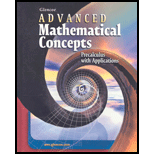
Concept explainers
a.
To calculate: The median of the lengths.
a.
Answer to Problem 20E
The median is
Explanation of Solution
Given information:
There are seven navigable rivers that feed into the Ohio river. The lengths of these rivers are
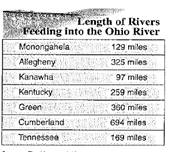
Formula used:
Median for even terms =
Median for odd terms =
Calculation:
Consider the data in ascending order ,
Since there are seven rivers. So,
There is odd number of data.
The median of odd number of data is −
Hence, the median is
b.
To calculate: The first quartile point and the third quartile point.
b.
Answer to Problem 20E
The first quartile and third quartile are
Explanation of Solution
Given information:
There are seven navigable rivers that feed into the Ohio river. The lengths of these rivers are
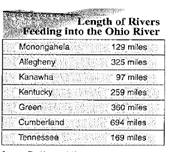
Formula used:
If each group has the median, the data is divided into four groups. Each group is called quartile.
Median for even terms =
Median for odd terms =
Calculation:
Consider the data in ascending order ,
Since there are seven rivers. So,
There is odd number of data.
The median of odd number of data is −
Therefore , the data is divided into two parts.
Lower half -
Median of lower half is −
Median of upper half is −
The quartile points are :-
Hence, the first quartile and third quartile are
c.
To calculate: The interquartile range.
c.
Answer to Problem 20E
The interquartile range is
Explanation of Solution
Given information:
There are seven navigable rivers that feed into the Ohio river. The lengths of these rivers are
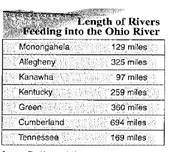
Formula used:
The difference between the first quartile point and third quartile point is called the inter- quartile range.
Calculation:
Consider the data in ascending order ,
Since there are seven rivers. So,
There is odd number of data.
The median of odd number of data is
The quartile points are :-
The inter- quartile range is
Hence, the interquartile range is
d.
To calculate: The semi-interquartile range.
d.
Answer to Problem 20E
The semi-interquartile range is
Explanation of Solution
Given information:
There are seven navigable rivers that feed into the Ohio river. The lengths of these rivers are

Formula used:
The inter- quartile range is divided by 2, the quotient is called the semi- interquartile range.
Calculation:
Consider the data in ascending order ,
Since there are seven rivers. So,
There is odd number of data.
The median of odd number of data is
The quartile points are :-
The inter- quartile range is
The semi-interquartile range -
Hence, the semi-interquartile range is
e.
To show: whether there is any outliers.
e.
Answer to Problem 20E
There are no outliers.
Explanation of Solution
Given information:
There are seven navigable rivers that feed into the Ohio river. The lengths of these rivers are
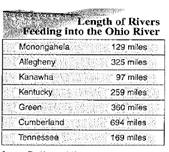
Formula used:
Outliers are extreme values that are more than 1.5 times the interquartile range beyond the upper or lower quartiles .
Calculation:
Consider the data in ascending order ,
Since there are seven rivers. So,
There is odd number of data.
The median of odd number of data is
The quartile points are :-
The inter- quartile range is
For outlier
The lower extreme 97 and the upper extreme 694 are within the limits.
So, there are no outliers.
f.
To sketch: A box-and-whisker plot of the lengths of the rivers.
f.
Explanation of Solution
Given information:
There are seven navigable rivers that feed into the Ohio river. The lengths of these rivers are
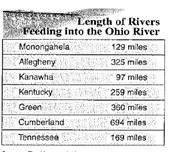
Graph:

Interpretation:
The vertical graph is known as box-and-whisker plots. It represents the length of the seven rivers. The median is 259. It does not have outliers.
g.
To discuss: The variability of the data.
g.
Explanation of Solution
Given information:
There are seven navigable rivers that feed into the Ohio river. The lengths of these rivers are
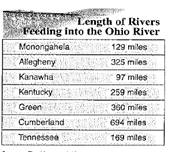
Summary:
Variability of the data can be studied by box-and-whisker plot.
It represent the median, quartiles, interquartile range , and extreme values in a set of the data.
| Terms | 7 |
| Median | 259 |
| 129 | |
| 360 | |
| Interquartile | 231 |
| Semi-interquartile | 115.5 |
| Outliers | No |
Thus, the box-and-whisker drawn in previous part is a pictorial representation of the variability of the data.
Chapter 14 Solutions
Advanced Mathematical Concepts: Precalculus with Applications, Student Edition
Additional Math Textbook Solutions
Precalculus (10th Edition)
University Calculus: Early Transcendentals (4th Edition)
Calculus: Early Transcendentals (3rd Edition)
Calculus: Early Transcendentals (2nd Edition)
University Calculus: Early Transcendentals (3rd Edition)
 Calculus: Early TranscendentalsCalculusISBN:9781285741550Author:James StewartPublisher:Cengage Learning
Calculus: Early TranscendentalsCalculusISBN:9781285741550Author:James StewartPublisher:Cengage Learning Thomas' Calculus (14th Edition)CalculusISBN:9780134438986Author:Joel R. Hass, Christopher E. Heil, Maurice D. WeirPublisher:PEARSON
Thomas' Calculus (14th Edition)CalculusISBN:9780134438986Author:Joel R. Hass, Christopher E. Heil, Maurice D. WeirPublisher:PEARSON Calculus: Early Transcendentals (3rd Edition)CalculusISBN:9780134763644Author:William L. Briggs, Lyle Cochran, Bernard Gillett, Eric SchulzPublisher:PEARSON
Calculus: Early Transcendentals (3rd Edition)CalculusISBN:9780134763644Author:William L. Briggs, Lyle Cochran, Bernard Gillett, Eric SchulzPublisher:PEARSON Calculus: Early TranscendentalsCalculusISBN:9781319050740Author:Jon Rogawski, Colin Adams, Robert FranzosaPublisher:W. H. Freeman
Calculus: Early TranscendentalsCalculusISBN:9781319050740Author:Jon Rogawski, Colin Adams, Robert FranzosaPublisher:W. H. Freeman
 Calculus: Early Transcendental FunctionsCalculusISBN:9781337552516Author:Ron Larson, Bruce H. EdwardsPublisher:Cengage Learning
Calculus: Early Transcendental FunctionsCalculusISBN:9781337552516Author:Ron Larson, Bruce H. EdwardsPublisher:Cengage Learning





